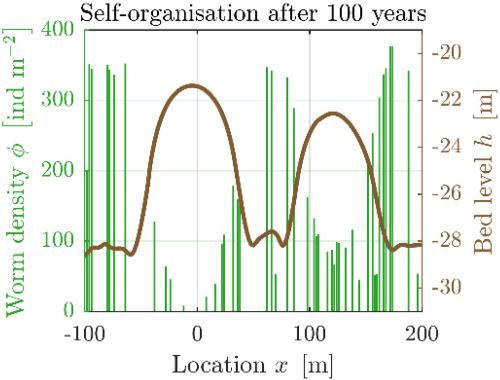当前位置:
X-MOL 学术
›
Earth Surf.Process. Land.
›
论文详情
Our official English website, www.x-mol.net, welcomes your feedback! (Note: you will need to create a separate account there.)
Biogeomorphology in the marine landscape: modelling the feedbacks between patches of the polychaete worm Lanice conchilega and tidal sand waves
Earth Surface Processes and Landforms ( IF 3.3 ) Pub Date : 2020-07-02 , DOI: 10.1002/esp.4914 Johan H. Damveld 1 , Bas W. Borsje 1 , Pieter C. Roos 1 , Suzanne J. M. H. Hulscher 1
Earth Surface Processes and Landforms ( IF 3.3 ) Pub Date : 2020-07-02 , DOI: 10.1002/esp.4914 Johan H. Damveld 1 , Bas W. Borsje 1 , Pieter C. Roos 1 , Suzanne J. M. H. Hulscher 1
Affiliation

|
Tidal sand waves are dynamic bedforms found in coastal shelf seas. Moreover, these areas are inhabited by numerous benthic species, of which the spatial distribution is linked to the morphological structure of sand waves. Especially the tube‐building worm Lanice conchilega is of interest as this organism forms small mounds on the seabed which provide shelter to other organisms. We investigate how the interactions between small‐scale mounds (height ~dm) and large‐scale sand waves (height~m) shape the bed of the marine environment. To this end, we present a two‐way coupled process‐based model of sand waves and tube‐building worm patches in Delft3D. The population density evolves according to a general law of logistic growth, with the bed shear stress controlling the carrying capacity. Worm patches are randomly seeded and the tubes are mimicked by small cylinders which influence flow and turbulence, thereby altering sediment dynamics. Model results relate the patches with the highest worm densities to the sand wave troughs, which qualitatively agrees with field observations. Furthermore, the L. conchilega tubes trigger the formation of sandy mounds on the seabed. Due to the population density distribution, the mounds in the troughs can be several centimetres higher than on the crests. Regarding sand wave morphology, the combination of patches and mounds are found to shorten the time‐to‐equilibrium. Also, if the initial bed comprised small sinusoidal sand waves, the equilibrium wave height decreased with a few decimetres compared to the situation without worm patches. As the time scale of mound formation (years) is shorter than that of sand wave evolution (decades), the mounds induce (and accelerate) sand wave growth on a similar spatial scale as the mounds. Initially this leads to shorter sand waves than they would be in an abiotic environment. However, near equilibrium the wavelengths tend towards their abiotic counterparts again.
中文翻译:

海洋景观中的生物地貌学:模拟多毛类蠕虫 Lanice conchilega 斑块与潮汐沙波之间的反馈
潮汐沙波是在沿海陆架海中发现的动态海床。此外,这些地区栖息着众多底栖物种,其空间分布与沙波的形态结构有关。尤其是管建造蠕虫 Lanice conchilega 是令人感兴趣的,因为这种生物在海床上形成小丘,为其他生物提供庇护所。我们研究了小型土丘(高度~dm)和大型沙波(高度~m)之间的相互作用如何塑造海洋环境的床。为此,我们在 Delft3D 中提出了一种基于双向耦合过程的沙波和管道建造蠕虫补丁模型。人口密度根据逻辑增长的一般规律演变,床层剪应力控制着承载能力。蠕虫补丁随机播种,管子由影响流动和湍流的小圆柱体模拟,从而改变沉积物动力学。模型结果将蠕虫密度最高的斑块与沙波槽联系起来,这与实地观察定性一致。此外,L. conchilega 管触发了海床上沙丘的形成。由于人口密度分布,低谷中的土丘可能比波峰上的土丘高几厘米。关于沙波形态,发现斑块和土丘的组合可以缩短达到平衡的时间。此外,如果初始床包括小的正弦沙波,与没有蠕虫斑块的情况相比,平衡波高降低了几分米。由于土墩形成的时间尺度(年)比沙波演化的时间尺度(几十年)短,土墩在与土墩相似的空间尺度上诱发(并加速)了沙波生长。最初,这会导致沙波比在非生物环境中更短。然而,接近平衡时,波长再次趋向于它们的非生物对应物。
更新日期:2020-07-02
中文翻译:

海洋景观中的生物地貌学:模拟多毛类蠕虫 Lanice conchilega 斑块与潮汐沙波之间的反馈
潮汐沙波是在沿海陆架海中发现的动态海床。此外,这些地区栖息着众多底栖物种,其空间分布与沙波的形态结构有关。尤其是管建造蠕虫 Lanice conchilega 是令人感兴趣的,因为这种生物在海床上形成小丘,为其他生物提供庇护所。我们研究了小型土丘(高度~dm)和大型沙波(高度~m)之间的相互作用如何塑造海洋环境的床。为此,我们在 Delft3D 中提出了一种基于双向耦合过程的沙波和管道建造蠕虫补丁模型。人口密度根据逻辑增长的一般规律演变,床层剪应力控制着承载能力。蠕虫补丁随机播种,管子由影响流动和湍流的小圆柱体模拟,从而改变沉积物动力学。模型结果将蠕虫密度最高的斑块与沙波槽联系起来,这与实地观察定性一致。此外,L. conchilega 管触发了海床上沙丘的形成。由于人口密度分布,低谷中的土丘可能比波峰上的土丘高几厘米。关于沙波形态,发现斑块和土丘的组合可以缩短达到平衡的时间。此外,如果初始床包括小的正弦沙波,与没有蠕虫斑块的情况相比,平衡波高降低了几分米。由于土墩形成的时间尺度(年)比沙波演化的时间尺度(几十年)短,土墩在与土墩相似的空间尺度上诱发(并加速)了沙波生长。最初,这会导致沙波比在非生物环境中更短。然而,接近平衡时,波长再次趋向于它们的非生物对应物。



























 京公网安备 11010802027423号
京公网安备 11010802027423号